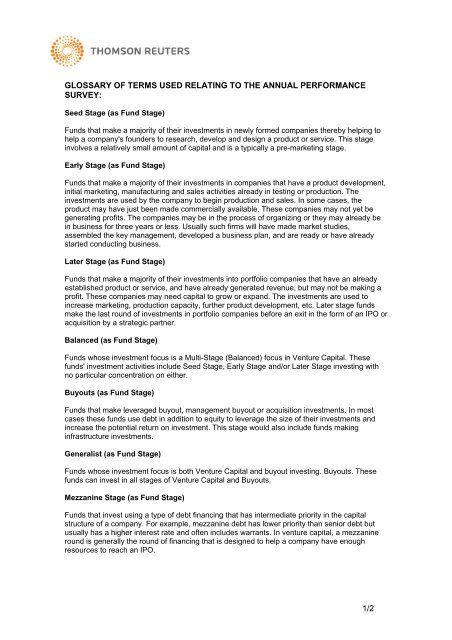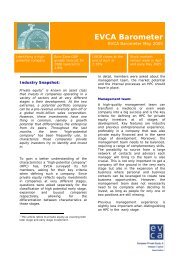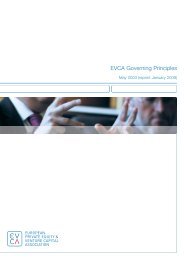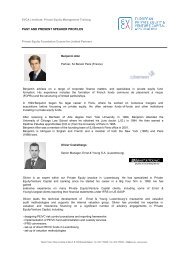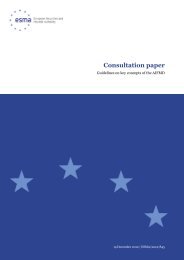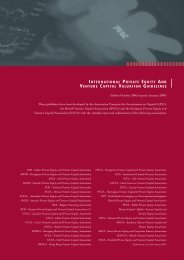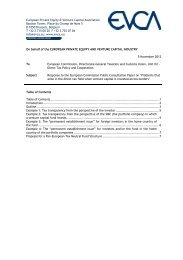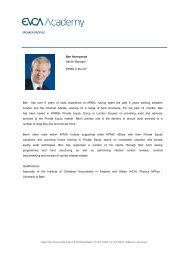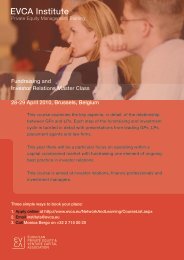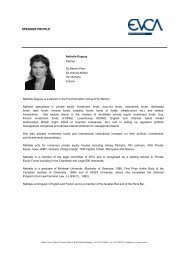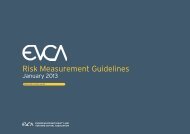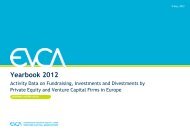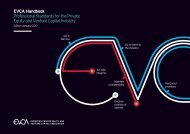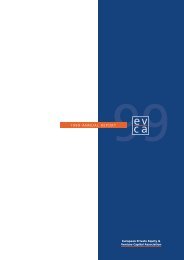here for glossary of terms and definitions - EVCA
here for glossary of terms and definitions - EVCA
here for glossary of terms and definitions - EVCA
Create successful ePaper yourself
Turn your PDF publications into a flip-book with our unique Google optimized e-Paper software.
GLOSSARY OF TERMS USED RELATING TO THE ANNUAL PERFORMANCE<br />
SURVEY:<br />
Seed Stage (as Fund Stage)<br />
Funds that make a majority <strong>of</strong> their investments in newly <strong>for</strong>med companies t<strong>here</strong>by helping to<br />
help a company's founders to research, develop <strong>and</strong> design a product or service. This stage<br />
involves a relatively small amount <strong>of</strong> capital <strong>and</strong> is a typically a pre-marketing stage.<br />
Early Stage (as Fund Stage)<br />
Funds that make a majority <strong>of</strong> their investments in companies that have a product development,<br />
initial marketing, manufacturing <strong>and</strong> sales activities already in testing or production. The<br />
investments are used by the company to begin production <strong>and</strong> sales. In some cases, the<br />
product may have just been made commercially available. These companies may not yet be<br />
generating pr<strong>of</strong>its. The companies may be in the process <strong>of</strong> organizing or they may already be<br />
in business <strong>for</strong> three years or less. Usually such firms will have made market studies,<br />
assembled the key management, developed a business plan, <strong>and</strong> are ready or have already<br />
started conducting business.<br />
Later Stage (as Fund Stage)<br />
Funds that make a majority <strong>of</strong> their investments into portfolio companies that have an already<br />
established product or service, <strong>and</strong> have already generated revenue, but may not be making a<br />
pr<strong>of</strong>it. These companies may need capital to grow or exp<strong>and</strong>. The investments are used to<br />
increase marketing, production capacity, further product development, etc. Later stage funds<br />
make the last round <strong>of</strong> investments in portfolio companies be<strong>for</strong>e an exit in the <strong>for</strong>m <strong>of</strong> an IPO or<br />
acquisition by a strategic partner.<br />
Balanced (as Fund Stage)<br />
Funds whose investment focus is a Multi-Stage (Balanced) focus in Venture Capital. These<br />
funds' investment activities include Seed Stage, Early Stage <strong>and</strong>/or Later Stage investing with<br />
no particular concentration on either.<br />
Buyouts (as Fund Stage)<br />
Funds that make leveraged buyout, management buyout or acquisition investments. In most<br />
cases these funds use debt in addition to equity to leverage the size <strong>of</strong> their investments <strong>and</strong><br />
increase the potential return on investment. This stage would also include funds making<br />
infrastructure investments.<br />
Generalist (as Fund Stage)<br />
Funds whose investment focus is both Venture Capital <strong>and</strong> buyout investing. Buyouts. These<br />
funds can invest in all stages <strong>of</strong> Venture Capital <strong>and</strong> Buyouts.<br />
Mezzanine Stage (as Fund Stage)<br />
Funds that invest using a type <strong>of</strong> debt financing that has intermediate priority in the capital<br />
structure <strong>of</strong> a company. For example, mezzanine debt has lower priority than senior debt but<br />
usually has a higher interest rate <strong>and</strong> <strong>of</strong>ten includes warrants. In venture capital, a mezzanine<br />
round is generally the round <strong>of</strong> financing that is designed to help a company have enough<br />
resources to reach an IPO.<br />
1/2
Other Private Equity/Special Situation (as Fund Stage)<br />
Funds that invest in companies which cannot be classified in the other fund stage categories.<br />
Special Situation funds would be included in this fund stage classification. Other private equity<br />
funds may include publicly traded funds, hybrid funds, or hedge funds.<br />
Turnaround/Distressed Debt (as Fund Stage)<br />
Funds that invest in underper<strong>for</strong>ming companies. Turnaround funds may use both debt <strong>and</strong><br />
equity to invest in companies <strong>and</strong> employ a variety <strong>of</strong> tactics to improve pr<strong>of</strong>itability <strong>and</strong><br />
increase revenue. Distressed Debt Funds make investments in companies that are in<br />
bankruptcy proceedings or already bankrupt. These funds purchase outst<strong>and</strong>ing debt from a<br />
company at a discount. Most distressed debt funds that are managed by private equity firms<br />
make controlled debt investments, meaning they take an active seat on the company board or a<br />
management position within the company. Restructuring Funds are funds that invest in<br />
companies that have a large amount <strong>of</strong> debt, are in default <strong>of</strong> creditors, have insufficient liquidity<br />
or lack capital assets. The funds look to restructure or eliminate these liabilities <strong>for</strong> the company.<br />
Recap Funds are funds that make investments that include a reorganization <strong>of</strong> a company's<br />
capital structure. Often Recap Funds will sell <strong>of</strong>f non-essential assets, or pay down debt that a<br />
company owes.<br />
Industry Focus<br />
The industry sector/s specially mentioned by the fund managers in the fund’s stated investment<br />
policy. The selection checked should also reflect the current investments <strong>of</strong> the fund.<br />
IRR (Internal Rate <strong>of</strong> Return)<br />
The IRR is the interim net return earned by investors (Limited Partners), from the fund from<br />
inception to a stated date. The IRR is calculated as an annualized effective compounded rate<br />
<strong>of</strong> return using monthly cash flows to <strong>and</strong> from the investors, together with the Residual Value<br />
as a terminal cash flow to investors. The IRR is t<strong>here</strong><strong>for</strong>e net, ie after deduction <strong>of</strong> all fees <strong>and</strong><br />
carried interest. In cases <strong>of</strong> captives or semi-captive investment vehicles without fees or carried<br />
interest, the IRR is adjusted to create a synthetic net return using assumed fees <strong>and</strong> carried<br />
interest.<br />
NAV (Net Asset Value) / Residual Value<br />
Total assets less total liabilities <strong>of</strong> the fund at a specific date at fair value (so NAV is net<br />
<strong>of</strong> management fees <strong>and</strong> any carry owed on the Residual Value <strong>of</strong> the portfolio).<br />
.<br />
2/2


